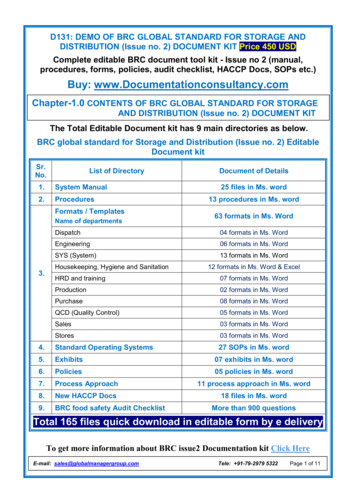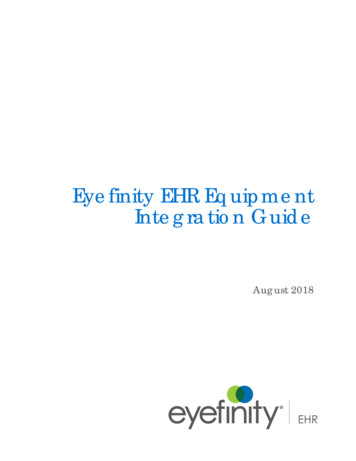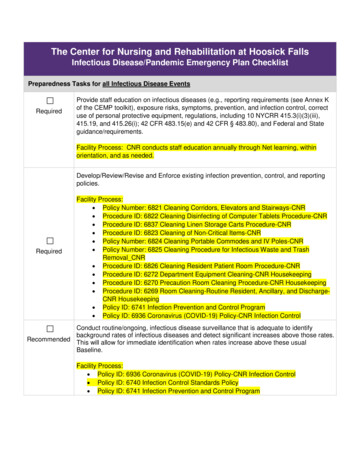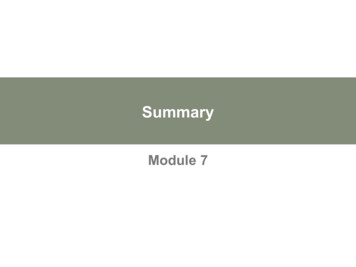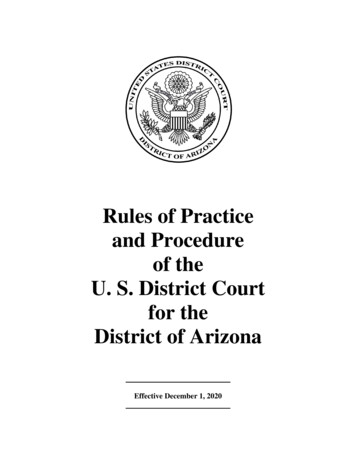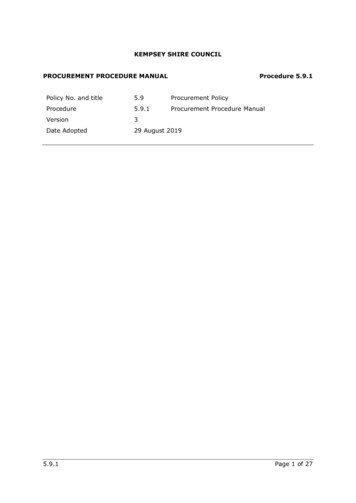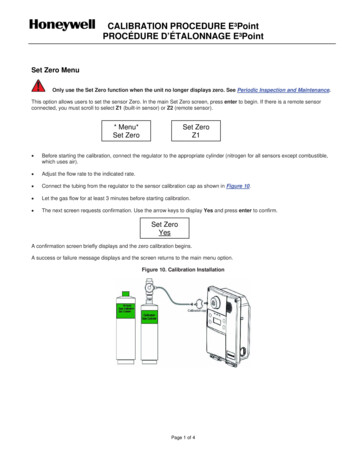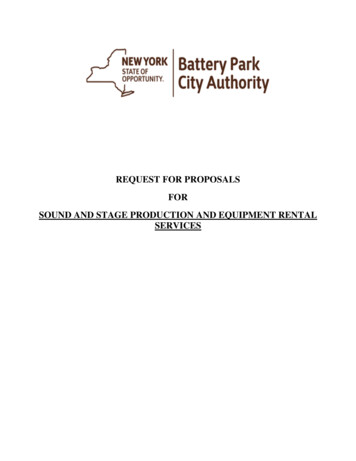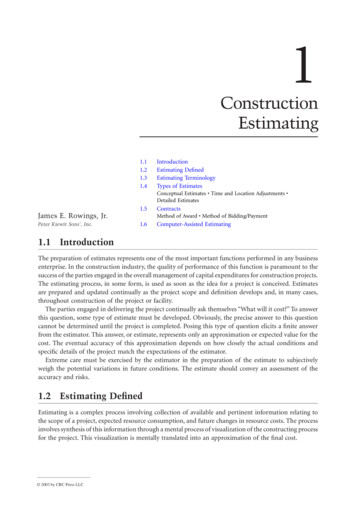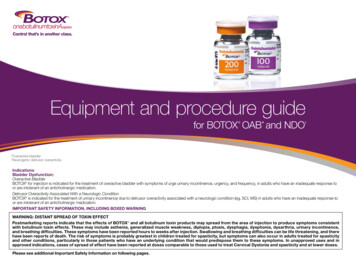
Transcription
Control that’s in another class.Equipment and procedure guidefor BOTOX OAB* and NDO †*Overactive bladder.Neurogenic detrusor overactivity.†IndicationsBladder Dysfunction:Overactive BladderBOTOX for injection is indicated for the treatment of overactive bladder with symptoms of urge urinary incontinence, urgency, and frequency, in adults who have an inadequate response toor are intolerant of an anticholinergic medication.Detrusor Overactivity Associated With a Neurologic ConditionBOTOX is indicated for the treatment of urinary incontinence due to detrusor overactivity associated with a neurologic condition (eg, SCI, MS) in adults who have an inadequate response toor are intolerant of an anticholinergic medication.IMPORTANT SAFETY INFORMATION, INCLUDING BOXED WARNINGWARNING: DISTANT SPREAD OF TOXIN EFFECTPostmarketing reports indicate that the effects of BOTOX and all botulinum toxin products may spread from the area of injection to produce symptoms consistentwith botulinum toxin effects. These may include asthenia, generalized muscle weakness, diplopia, ptosis, dysphagia, dysphonia, dysarthria, urinary incontinence,and breathing difficulties. These symptoms have been reported hours to weeks after injection. Swallowing and breathing difficulties can be life threatening, and therehave been reports of death. The risk of symptoms is probably greatest in children treated for spasticity, but symptoms can also occur in adults treated for spasticityand other conditions, particularly in those patients who have an underlying condition that would predispose them to these symptoms. In unapproved uses and inapproved indications, cases of spread of effect have been reported at doses comparable to those used to treat Cervical Dystonia and spasticity and at lower doses.Please see additional Important Safety Information on following pages.
BOTOX equipment Order what you want, when you want it, with Allergan DirectEnrolling in Allergan Direct provides you with online convenience, so you can manage your account,purchase products, pay your Allergan bills, and access valuable account reports around your schedule.Set up an account with Allergan Direct today by calling Allergan customer service at1-855-246-3728. Once your account is established, you can order BOTOX and other products through Allergan Direct at: AllerganDirect.com.Ordering BOTOX When ordering BOTOX by phone or online, please use the following National Drug Codes (NDCs):BOTOX 100-Unit vial:NDC 0023-1145-01BOTOX 200-Unit vial:NDC 0023-3921-02Unopened vials of BOTOX should be stored in a refrigerator (2 C – 8 C) for up to 36 months for the 100-Unit vial or up to 24 monthsfor the 200-Unit vial.IMPORTANT SAFETY INFORMATION (continued)CONTRAINDICATIONSBOTOX is contraindicated in the presence of infectionat the proposed injection site(s) and in patients who arehypersensitive to any botulinum toxin product or to anyof the components in the formulation.BOTOX is contraindicated for intradetrusor injectionin patients with a urinary tract infection; or in patientswith urinary retention or post-void residual (PVR) urinevolume 200 mL who are not routinely performingclean intermittent self-catheterization (CIC).WARNINGS AND PRECAUTIONSLack of Interchangeability Between BotulinumToxin ProductsThe potency Units of BOTOX are specific to thepreparation and assay method utilized. Theyare not interchangeable with other preparationsof botulinum toxin products and, therefore,Units of biological activity of BOTOX cannotbe compared to nor converted into Units of anyother botulinum toxin products assessed withany other specific assay method.Please see additional Important SafetyInformation on following pages.
Flexible and rigid needle informationIMPORTANT SAFETY INFORMATION (continued)WARNINGS AND PRECAUTIONS (continued)Spread of Toxin EffectSee Boxed Warning.Serious Adverse Reactions With Unapproved UseSerious adverse reactions, including excessiveweakness, dysphagia, and aspiration pneumonia,with some adverse reactions associated with fataloutcomes, have been reported in patients whoreceived BOTOX injections for unapproved uses.In these cases, the adverse reactions were notnecessarily related to distant spread of toxin, but mayhave resulted from the administration of BOTOX to thesite of injection and/or adjacent structures. In severalof the cases, patients had pre-existing dysphagiaor other significant disabilities. There is insufficientinformation to identify factors associated with anincreased risk for adverse reactions associated withthe unapproved uses of BOTOX . The safety andeffectiveness of BOTOX for unapproved uses have notbeen established.Please see additional Important SafetyInformation on following pages.For your convenience, you can order some cystoscopic injection needlesthrough AllerganFLEXIBLESupplierNameLaborieinjeTAK ugeFrenchSizeTipLength9600923G4.8FAdjustable 70 cmdepth of0 mm,2, mm,3 mm,4 mm,or 5 sposable needle;70-cm adjustabletip lengthPrice*Allergan Ordering2 needlesfor 96.00Online order:allergandirect.comPhone mRIGIDSupplierNameColoplastBoNee BladderInjectionNeedle†9482522G5F4 mm35 cmLaborieinjeTAK ustabledepth of0 mm, 2 mm,3 mm, 4 mm,or 5 mm35 cmNeedleCompanyWebsitePrice*Allergan OrderingRigid needle1 needlefor 36.00Online order:allergandirect.comPhone order:1-800-377-7790coloplast.usDisposable needle;35-cm adjustabletip length2 needlesfor 74.00Online order:allergandirect.comPhone order:1-800-377-7790laborie.comFor more detailed information on the abovementioned needles, please visit their respective websites: coloplast.us and laborie.com.For concerns or nonmedical issues, call 1-800-442-6869, option 2.* Price includes ground shipping. Prices are subject to change.†These needles are just 2 of the options that can be usedfor flexible or rigid cystoscopes. The needles representedhere were commonly used in clinical trials, but this is not anexhaustive list of all needle options. Contact your equipmentrepresentative for additional options.Notwithstanding the above, this list should not be construed, inany way, as an endorsement or recommendation by Allerganas to the quality or appropriateness of any needle on this list.Allergan makes no guarantees that using a needle from this listwill result in your desired outcome. It is wholly and solely yourresponsibility to assess the quality and appropriateness of theneedles you use to perform the procedure.
Flexible needle informationOrder these needles directly from the supplierFLEXIBLEPartFrenchPartFrench rkingWorking ProductProductPriceList Price*LengthLength ce BoNee BladderInjectionNeedleNBI070NBI07022G22G5F5F4 .uscoloplast.usLaborieinjeTAK 70-cmadjustableadjustableneedletip ��21–4: 119.00/box 137.00/box3–7 99.00/box5–9: 109.00/box8 89.00/box10 : ion101CNeedle Set0427MAJ-656Flexcystoscope MAJNeedle Sheath 65525G6FAdjustableAdjustable 7070cmcmdepthdepthofof2,03,mm,4, or5 2mmmm,3 mm,4 mm,4 mm105 cmor 5 mm6F6F4 mm4 mm105 cm105 cmContact CustomerService tCustomerService25GN/A6F6F4 mmN/A105 cmN/ASupplierNameColoplastOlympusFlexcystoscope MAJNeedle656*Prices are subject to change.27GN/A4 mm105 cmFlexibleFlexibleandand 68.00 74.00rigidrigidneedlesneedles 225.00 TANT SAFETY INFORMATION (continued)WARNINGS AND PRECAUTIONS (continued)Hypersensitivity ReactionsSerious and/or immediate hypersensitivity reactionshave been reported. These reactions includeanaphylaxis, serum sickness, urticaria, soft-tissueedema, and dyspnea. If such a reaction occurs,further injection of BOTOX should be discontinuedand appropriate medical therapy immediately instituted.One fatal case of anaphylaxis has been reportedin which lidocaine was used as the diluent, andconsequently the causal agent cannot bereliably determined.Please see additional Important SafetyInformation on following pages.
Rigid needle informationOrder these needles directly from the kingLengthProductDescriptionList Price*Customer ServicePhone NumberBoNee BladderInjectionNeedleNBI03522G5F4 mm35 cmRigid needle InjectionNeedlesG1422023G5F8 mm35 cmcookmedical.com23G3.7F8 mm35 tCustomerServiceG1611223G5F8 mm45 cmG1527625G5F8 mm35 .8FAdjustabledepth of0 mm,2 mm,3 mm,4 mm,or 5 mm35 cmDisposableneedle;35-cmadjustabletip length2 to a box1-800-522-67431–4: 114.00/box5‑9: 87.00/box10 : AWE-NN/A3FN/AN/AReusableinjectionneedle 400.00olympus.com *Prices are subject to change.1-800-852-9361IMPORTANT SAFETY INFORMATION (continued)WARNINGS AND PRECAUTIONS (continued)Increased Risk of Clinically Significant EffectsWith Pre-existing Neuromuscular DisordersIndividuals with peripheral motor neuropathicdiseases, amyotrophic lateral sclerosis (ALS), orneuromuscular junction disorders (eg, myastheniagravis or Lambert-Eaton syndrome) should bemonitored when given botulinum toxin. Patientswith known or unrecognized neuromusculardisorders or neuromuscular junction disorders maybe at increased risk of clinically significant effectsincluding generalized muscle weakness, diplopia,ptosis, dysphonia, dysarthria, severe dysphagia, andrespiratory compromise from therapeutic doses ofBOTOX (see Warnings and Precautions).Please see additional Important SafetyInformation on following pages.
Procedure setup/preferenceThe supplies and equipment needed to inject BOTOX into the detrusor are similar to those required forcystoscopy and are commonly used in a Urology office.Supplies for reconstitution and preparationBOTOX injection for OAB 11 mL of sterile, nonpreserved 0.9% saline (10 mLfor reconstituting BOTOX and 1 mL for final flush) One 10-mL syringe* and an additional syringe* for1-mL flush 21-gauge needle (a different injection needle willbe used during the injection procedure) Alcohol swabs Sterile glovesLocal anesthesia and general supplies Lidocaine jelly or similar (for comfort during scopeinsertion) Lidocaine (50 cc)– 1% to 2% lidocaine or similar-acting agent forlocal anesthesia with or without sedation Catheter tip syringe (50 cc-60 cc) Straight catheter (14F-16F) Sterile gloves Standard office sedative (optional)BOTOX injection for NDO 31 mL of sterile, nonpreserved 0.9% saline (30 mLfor reconstituting BOTOX and 1 mL for final flush) Three 10-mL syringes* and an additional syringe*for 1-mL flush 21-gauge needle (a different injection needle willbe used during the injection procedure) Alcohol swabs Sterile glovesEquipment for BOTOX injection Cysto set and tubing In addition to a rigid or flexible cystoscope witha working channel, equipment requirementsmay include:– Recommended sterile water– Vial of BOTOX – Light cord and light source– Camera and video monitor† (optional)– Compatible cystoscopic injection needle†– Stopcock peak to your Allergan Urology Medical Consultant aboutScompatible cystoscopic needles and access to video equipment.†*Luer-Lok syringes are recommended.IMPORTANT SAFETY INFORMATION (continued)WARNINGS AND PRECAUTIONS (continued)Dysphagia and Breathing DifficultiesTreatment with BOTOX and other botulinum toxinproducts can result in swallowing or breathingdifficulties. Patients with pre-existing swallowing orbreathing difficulties may be more susceptible to thesecomplications. In most cases, this is a consequence ofweakening of muscles in the area of injection that areinvolved in breathing or oropharyngeal muscles thatcontrol swallowing or breathing (see Boxed Warning).Please see additional Important SafetyInformation on following pages.
Pretreatment counselingTopics to cover using language your patient will understandDiscuss the risk of urinary tract infection (UTI) and how you will address it Explain how you will make efforts to reduce the risk of a UTI– “To help prevent a urinary tract infection, we’ll prescribe an antibiotic for you to take 1 to 3 daysbefore your treatment, on the day of your treatment, and for 1 to 3 days after your treatment”Demystify retention and self-catheterization with these 3 key points:1. Highlight the actual risk observed in clinical studies.– “94 out of every 100 patients in clinical studies did not need to self-catheterize.1 Also, rememberthat if it happens, it’s temporary. We’ll be here to help you”2. S hare your personal experience in treating other patients.– Also, consider using “temporary inability to empty your bladder” or “incomplete bladder emptying”instead of the word “retention”2– “I’ve had a small percentage of patients who had incomplete bladder emptying and needed to selfcatheterize. For those who did, it was usually temporary and we helped them out along the way”3. I f a patient expresses concern, show the self-catheter’s ease of use.– “This is very different from a catheter you see in the hospital. You can carry it in your purse orpocket. It is ready to use when it’s needed”– “You can do it on your own, in private. The urine goes right into the toilet”– “If you ever needed to use one, we would show you how”Address discontinuation of anti-platelet therapy Explain the need to discontinue anti-platelet therapy at least 3 days before the procedureDiscuss patient comfort management “One option is anesthesia, or if you want the ease of doing it in the office, we numb your bladder”IMPORTANT SAFETY INFORMATION (continued)WARNINGS AND PRECAUTIONS (continued)Pulmonary Effects of BOTOX in Patients WithCompromised Respiratory Status Treatedfor Detrusor Overactivity Associated With aNeurologic ConditionPatients with compromised respiratory status treatedwith BOTOX for detrusor overactivity associated with aneurologic condition should be monitored closely.Autonomic Dysreflexia in Patients Treatedfor Detrusor Overactivity Associated With aNeurologic ConditionAutonomic dysreflexia associated with intradetrusorinjections of BOTOX could occur in patients treatedfor detrusor overactivity associated with a neurologiccondition and may require prompt medical therapy. Inclinical trials, the incidence of autonomic dysreflexiawas greater in patients treated with BOTOX 200 Unitscompared with placebo (1.5% vs 0.4%, respectively).Please see additional Important SafetyInformation on following pages.
Injection procedureUsing a flexible or rigid cystoscope, BOTOX canbe administered in the office, ambulatory surgicalcenter, or outpatient operating room.1For rigid scopes: 30-degree lens preferred 17F-21F sheathInstill the bladder with enough saline to achieve adequatevisualization (overdistension should be avoided).1Optional: Before reconstituting BOTOX , perform cystoscopy todetermine whether the patient has a condition that would preventBOTOX administration.Please see Warnings and Precautions in the Important SafetyInformation on the risk of autonomic dysreflexia in patients treatedfor detrusor overactivity associated with a neurologic condition.IMPORTANT SAFETY INFORMATION (continued)WARNINGS AND PRECAUTIONS (continued)Urinary Tract Infections in Patients WithOveractive BladderBOTOX increases the incidence of urinary tractinfection. Clinical trials for overactive bladder excludedpatients with more than 2 UTIs in the past 6 monthsand those taking antibiotics chronically due to recurrentUTIs. Use of BOTOX for the treatment of overactivebladder in such patients and in patients with multiplerecurrent UTIs during treatment should only beconsidered when the benefit is likely to outweigh thepotential risk.Urinary Retention in Patients Treated forBladder DysfunctionDue to the risk of urinary retention, treat only patientswho are willing and able to initiate catheterization posttreatment, if required, for urinary retention.In patients who are not catheterizing, post-void residual(PVR) urine volume should be assessed within 2weeks post treatment and periodically as medicallyappropriate up to 12 weeks, particularly in patientswith multiple sclerosis or diabetes mellitus. Dependingon patient symptoms, institute catheterization if PVRurine volume exceeds 200 mL and continue until PVRfalls below 200 mL. Instruct patients to contact theirphysician if they experience difficulty in voiding ascatheterization may be required.Please see additional Important SafetyInformation on following pages.
Injection procedure (continued)2Reconstitute BOTOX per label. Keep unopened vials of BOTOX refrigerated (2 C–8 C) until ready to use. 1DOSAGE INFORMATIONUsageOveractive Bladder (OAB)Neurogenic Detrusor Overactivity (NDO)Dose100 Units of reconstituted BOTOX (5 Units per 0.5 mL)200 Units of reconstituted BOTOX (6.7 Units per 1 mL)Reconstitution100 Units BOTOX in 10-mL sterile, nonpreserved 0.9%saline as well as 1-mL syringe of saline for final flush200 Units BOTOX in 30-mL sterile, nonpreserved 0.9%saline as well as 1-mL syringe of saline for final flushStorageAdminister BOTOX within 24 hours of reconstitution inAdminister BOTOX within 24 hours of reconstitution inthe vial. During this time, reconstituted BOTOX should be the vial. During this time, reconstituted BOTOX should bestored in a refrigerator (2 C–8 C).stored in a refrigerator (2 C–8 C).Number ofInjections20 injections of 0.5 mL each30 injections of 1 mL eachIMPORTANT SAFETY INFORMATION (continued)WARNINGS AND PRECAUTIONS (continued)Urinary Retention in Patients Treated for BladderDysfunction (continued)Overactive BladderIn clinical trials, 6.5% of patients (36/552) initiatedclean intermittent catheterization for urinary retentionfollowing treatment with BOTOX 100 Units ascompared to 0.4% of patients (2/542) treated withplacebo. The median duration of catheterization forpatients treated with BOTOX 100 Units was 63 days(minimum 1 day to maximum 214 days) as comparedto a median duration of 11 days (minimum 3 days tomaximum 18 days) for patients receiving placebo.Patients with diabetes mellitus treated with BOTOX were more likely to develop urinary retention thannondiabetics. In clinical trials, 12.3% of patients (10/81)with diabetes developed urinary retention followingtreatment with BOTOX 100 Units vs 0% of patients(0/69) treated with placebo. In patients withoutdiabetes, 6.3% of patients (33/526) developed urinaryretention following treatment with BOTOX 100 Units vs0.6% of patients (3/516) treated with placebo.Please see additional Important SafetyInformation on following pages.
Injection procedure (continued)3Load the needle into the injection port.After removing the needle from its sterile packaging, load itthrough the working channel of the flexible or rigid cystoscope.You should not load the needle into a flexible cystoscope withouttaking precautions against damaging the working channel. Theprecautions you take will depend on the specific type or brand ofneedle (see Precautions for Flexible Cystoscopes below).PRECAUTIONS FOR FLEXIBLE CYSTOSCOPES to help prevent damage to the working channelIn general, make sure your flexible cystoscope is in a neutral position (not flexed) when inserting the needle.If the needle has a protective covering or cap: Leave the cap on as you pass the needle through the workingchannel. Once the covered tip of the needle is past the tip of the scope and is in view, the cap is removed and theneedle is withdrawn so that the tip is just inside the end of the scope. This would be performed outside the bladderas the protective covering or cap must be removed before entering the bladder.If the needle is inserted through a protective sheath: Place the protective sheath through the working portof the cystoscope; then pass the needle through the sheath. When you use a protective sheath, the needle can beinserted into the working channel either before or after the scope is passed into the bladder.If the needle is retractable: Ensure that your needle is properly retracted before loading it through the workingchannel. Before removal, confirm that the needle is no longer retracted. Then pull the needle straight back out of theworking channel with a consistent motion.IMPORTANT SAFETY INFORMATION (continued)WARNINGS AND PRECAUTIONS (continued)Urinary Retention in Patients Treated for BladderDysfunction (continued)Detrusor Overactivity Associated Witha Neurologic ConditionIn clinical trials, 30.6% of patients (33/108) who werenot using clean intermittent catheterization (CIC)prior to injection, required catheterization for urinaryretention following treatment with BOTOX 200 Unitsas compared to 6.7% of patients (7/104) treatedwith placebo. The median duration of postinjectioncatheterization for these patients treated withBOTOX 200 Units (n 33) was 289 days (minimum 1day to maximum 530 days) as compared to a medianduration of 358 days (minimum 2 days to maximum379 days) for patients receiving placebo (n 7).Among patients not using CIC at baseline, those withmultiple sclerosis were more likely to require CIC postinjection than those with spinal cord injury.Please see additional Important SafetyInformation on following pages.
Injection procedure (continued)4Prepare for injection into the detrusor.Lubricate patient’s urethral meatus and insert flexible or rigidcystoscope. Attach the first syringe of reconstituted BOTOX to theinjection needle. Prime the needle with reconstituted BOTOX . Thiswill remove the air bubbles inside the needle.IMPORTANT SAFETY INFORMATION (continued)WARNINGS AND PRECAUTIONS (continued)Human Albumin and Transmission ofViral DiseasesThis product contains albumin, a derivative of humanblood. Based on effective donor screening andproduct manufacturing processes, it carries anextremely remote risk for transmission of viral diseasesand variant Creutzfeldt-Jakob disease (vCJD). Thereis a theoretical risk for transmission of CreutzfeldtJakob disease (CJD), but if that risk actually exists,the risk of transmission would also be consideredextremely remote. No cases of transmission of viraldiseases, CJD, or vCJD have ever been identified forlicensed albumin or albumin contained in otherlicensed products.Please see additional Important SafetyInformation on following pages.
Injection procedure (continued)5IMPORTANT SAFETY INFORMATION (continued)ADVERSE REACTIONSAdverse reactions to BOTOX are discussed in greaterdetail in the following sections: Boxed Warning,Contraindications, and Warnings and Precautions.Please see additional Important SafetyInformation on following pages. istribute the injections evenly across the detrusor walls.DUnder direct visualization, inject reconstituted BOTOX (see Step 2 for specific injection per indication) into the detrusormuscle, avoiding the trigone.1,* Insert the needle approximately 2 mm into the detrusor muscle1 Space the injections approximately 1 cm apart1 Distribute the injections evenly across the detrusor walls as farlaterally as possible, ensuring injections are submucosalLook for a “bleb” in the bladderepithelium at each injection siteBLEB“Bleb,” or subtle rise in thebladder epithelium, indicatesproper needle insertion.*If you encounter a small amount of bleeding from an injection site, it should not interfere with the procedure.See Prescribing Information for more details.BLISTERThin, transparent, blister-like rise inthe bladder epithelium may indicateincorrect needle insertion.
Injection procedure (continued)67For the final injection, approximately 1 mL of sterile normalsaline should be injected so that the remaining BOTOX inthe needle is delivered to the bladder.1 emove the cystoscope and drain.RAfter the final injection, remove the cystoscope. The saline used forbladder visualization should be drained.Instruct your patients to contact you if they experience a burningsensation upon voiding or difficulties in voiding as a post-voidresidual (PVR) urine volume check may be needed. Also, ensureyour patients continue to take prophylactic antibiotics 1 to 3 dayspost injection to avoid UTI.IMPORTANT SAFETY INFORMATION (continued)ADVERSE REACTIONS (continued)Overactive BladderThe most frequently reported adverse reactions foroveractive bladder occurring within 12 weeks of injectioninclude urinary tract infection (BOTOX 18%, placebo6%), dysuria (BOTOX 9%, placebo 7%), urinary retention(BOTOX 6%, placebo 0%), bacteriuria (BOTOX 4%,placebo 2%), and residual urine volume (BOTOX 3%,placebo 0%).Please see additional Important SafetyInformation on following pages.
Follow-up8 Book re-treatment procedure appointment.For OAB patientsFor NDO patientsRe-treat atRe-treat at 6months1 10months1 R einject upon diminishing clinical effect of the previous BOTOX injection, but no sooner than 12 weeks from the prior bladderinjection. Reinjection should be based on the physician’sdiscretion and individual patient response1,*,†* In OAB, median time until patients qualified for the second treatment of BOTOX in double-blind,placebo-controlled clinical studies was 169 days ( 6 months), but no sooner than 12 weeksfrom the prior bladder injection.1In NDO, median time to qualification for re-treatment in the double-blind, placebo-controlledclinical studies was 295-337 days (10.5 months-12 months) for BOTOX 200 Units, but no soonerthan 12 weeks from the prior bladder injection.1† IMPORTANT SAFETY INFORMATION (continued)ADVERSE REACTIONS (continued)Overactive Bladder (continued)A higher incidence of urinary tract infection wasobserved in patients with diabetes mellitus treated withBOTOX 100 Units and placebo than nondiabetics.The incidence of UTI increased in patients whoexperienced a maximum post-void residual (PVR) urinevolume 200 mL following BOTOX injection comparedto those with a maximum PVR 200 mL followingBOTOX injection, 44% vs 23%, respectively.Please see additional Important SafetyInformation on following pages.
NotesIMPORTANT SAFETY INFORMATION (continued)ADVERSE REACTIONS (continued)Detrusor Overactivity Associated Witha Neurologic ConditionThe most frequently reported adverse reactions within12 weeks of BOTOX injection for detrusor overactivityassociated with a neurologic condition include urinarytract infection (BOTOX 24%, placebo 17%), urinaryretention (BOTOX 17%, placebo 3%), and hematuria(BOTOX 4%, placebo 3%).The following adverse event rates were reportedat any time following initial injection and prior toreinjection or study exit (median duration of 44 weeksof exposure): urinary tract infections (49%), urinaryretention (17%), constipation (4%), muscular weakness(4%), dysuria (4%), fall (3%), gait disturbance (3%), andmuscle spasm (2%).Postmarketing ExperienceAdverse reactions that have been identified duringpostapproval use of BOTOX are discussed in greaterdetail in Postmarketing Experience (Section 6.3 of thePrescribing Information).There have been spontaneous reports of death,sometimes associated with dysphagia, pneumonia,and/or other significant debility or anaphylaxis, aftertreatment with botulinum toxin. There have also beenreports of adverse events involving the cardiovascularsystem, including arrhythmia and myocardialinfarction, some with fatal outcomes. Some of thesepatients had risk factors including cardiovasculardisease. The exact relationship of these events to thebotulinum toxin injection has not been established.Please see additional Important SafetyInformation on following page.
Control that’s in another class.Equipment and procedure guidefor BOTOX OAB* and NDO †*Overactive bladder.Neurogenic detrusor overactivity.†IMPORTANT SAFETY INFORMATION (continued)DRUG INTERACTIONSCo-administration of BOTOX and other agents interfering with neuromuscular transmission (eg, aminoglycosides, curare-like compounds) should only be performed with caution as theeffect of the toxin may be potentiated. Use of anticholinergic drugs after administration of BOTOX may potentiate systemic anticholinergic effects. The effect of administering differentbotulinum neurotoxin products at the same time or within several months of each other is unknown. Excessive neuromuscular weakness may be exacerbated by administration ofanother botulinum toxin prior to the resolution of the effects of a previously administered botulinum toxin. Excessive weakness may also be exaggerated by administration of a musclerelaxant before or after administration of BOTOX .Please see BOTOX full Prescribing Information, including Boxed Warning and Medication Guide.References: 1. BOTOX Prescribing Information, June 2019. 2. Data on file, Allergan.All trademarks are the property of their respective owners. 2019 Allergan. All rights reserved.BUO81588-v7 08/19 192517
Equipment and procedure guide Control that's in another class. Indications Bladder Dysfunction: Overactive Bladder BOTOX for injection is indicated for the treatment of overactive bladder with symptoms of urge urinary incontinence, urgency, and frequency, in adults who have an inadequate response to or are intolerant of an anticholinergic medication.
